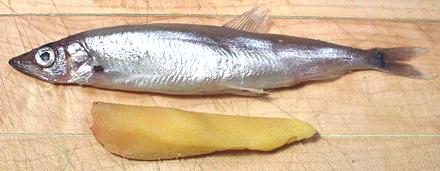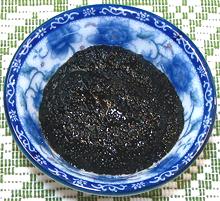 [Shishamo (Japan (with roe)); Mallotus villosus]
[Shishamo (Japan (with roe)); Mallotus villosus]
This fish is native to the Arctic region in both Atlantic and Pacific, venturing well above the Arctic Circle (in summer). They are found as far south as the northern tip of Japan and the US-Canada border in the Pacific. In the Atlantic they range as far south as the Gulf of Maine, USA and the British Isles. The largest concentrations are across the North Pacific and around the island of Newfoundland, Canada.
Capelin are harvested for fish meal and fish oil as well as for human consumption. Capelin roe (bottom in photo to the left) is a high value item and is served as masago in sushi bars in Japan and California. Asian markets here in Los Angeles sell capelin with roe when in season. Males grow to a bit over 7-3/4 inches, females to a little over 9-3/4 inches, but the photo specimen was 6 inches and weighed 7-1/2 ounces including 2-1/8 ounces of roe. IUCN Red Listed NE (Not Evaluated), but probably not threatened at this time.
More on Smelts.
 Shishamo (capelin with roe) is lightly battered and fried whole in
Japan.
Shishamo (capelin with roe) is lightly battered and fried whole in
Japan.
In sushi bars, the capelin eggs (masago) are usually dyed bright
red-orange.They are served on a dollop of sushi rice with a wrap of nori
seaweed around it to hold the eggs in place. For other markets they are
dyed black to resemble sturgeon caviar, or bright red. The individual
eggs are about 0.050 inch diameter (1.3 mm) The specimens (pasteurized)
were purchased on-line at 2016 US $4.40 per ounce.